
The Tibet Autonomous Region, officially the Xizang Autonomous Region, often shortened to Tibet or Xizang, is an autonomous region of China and is part of Southwestern China.
The administrative divisions of China have consisted of several levels since ancient times, due to China's large population and geographical area. The constitution of China provides for three levels of government. However in practice, there are five levels of local government; the provincial, prefecture, county, township, and village.
Ethnic minorities in China are the non-Han population in the People's Republic of China (PRC).

Qinghai is an inland province in Northwestern China. It is the largest province of China by area and has the third smallest population. Its capital and largest city is Xining.
Human rights in China are periodically reviewed by international bodies, such as human rights treaty bodies and the United Nations Human Rights Council's Universal Periodic Review. The Chinese Communist Party (CCP), the government of the People's Republic of China (PRC), their supporters, and other proponents claim that existing policies and enforcement measures are sufficient to guard against human rights abuses. However, other countries, international non-governmental organizations (NGOs) including Human Rights in China and Amnesty International, and citizens, lawyers, and dissidents inside the country, state that the authorities in mainland China regularly sanction or organize such abuses.
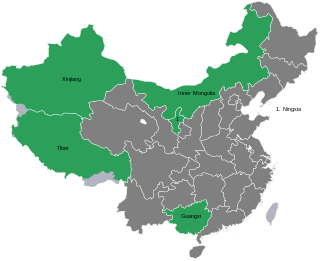
The autonomous regions are one of four types of province-level divisions of China. Like Chinese provinces, an autonomous region has its own local government, but under the law of the People's Republic of China, an autonomous region has more legislative rights, such as the right to "formulate self-government regulations and other separate regulations." An autonomous region is the highest level of minority autonomous entity in China, which has a comparably higher population of a particular minority ethnic group.
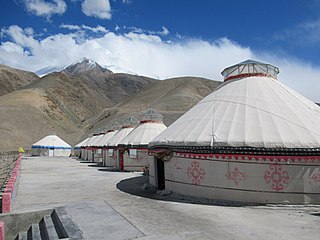
Kizilsu Kyrgyz Autonomous Prefecture is an autonomous prefecture in western Xinjiang, China, bordering Kyrgyzstan and Tajikistan. Its capital is Artux. The prefecture is home to 622,222 people and covers an area of 70,916 km2 (27,381 sq mi). Most Kyrgyz in China reside in Kizilsu; they make up a little over a quarter of the prefecture's population. The Uyghurs are the largest ethnic group in Kizilsu, consisting of nearly two-thirds of the population.

Bayingolin Mongol Autonomous Prefecture is an autonomous prefecture in the southeastern Xinjiang, China. It borders Gansu to the east, Qinghai to the southeast and the Tibet Autonomous Region to the south. It is the largest prefecture-level division nationally, with an area of 471,480 km2 (182,040 sq mi), which is even larger than its neighboring province of Gansu. The prefectural capital is Korla. Despite being designated an autonomous area for Mongols in China, only about four percent of Bayingolin's population is Mongol.

Autonomous prefectures are one type of autonomous administrative divisions of China, existing at the prefectural level, with either ethnic minorities forming over 50% of the population or being the historic home of significant minorities. Autonomous prefectures are mostly majority Han Chinese by population. The official name of an autonomous prefecture includes the most significant minority in that region, sometimes two, rarely three. For example, a Kazakh prefecture may be called Kazak Zizhizhou. Like all other prefectural level divisions, autonomous prefectures are divided into county level divisions. There is one exception: Ili Kazak Autonomous Prefecture contains two prefectures of its own. Under the Constitution of the People's Republic of China, autonomous prefectures cannot be abolished.
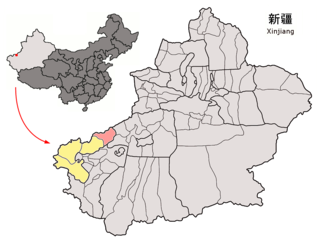
Akqi County is a county in Xinjiang Uygur Autonomous Region, China. It is under the administration of the Kizilsu Kyrgyz Autonomous Prefecture. The county has a town and five townships, six communities and 25 villages under its jurisdiction in 2018, its county seat is Akqi Town. The county has a population of about 46,000 with main ethnic groups of Kyrgyz, Han and Uyghur peoples.

Xinjiang, officially the Xinjiang Uygur Autonomous Region, is an autonomous region of the People's Republic of China (PRC), located in the northwest of the country at the crossroads of Central Asia and East Asia. Being the largest province-level division of China by area and the 8th-largest country subdivision in the world, Xinjiang spans over 1.6 million square kilometres (620,000 sq mi) and has about 25 million inhabitants. Xinjiang borders the countries of Afghanistan, Kazakhstan, Kyrgyzstan, Mongolia, Pakistan, Russia, Tajikistan, and India. The rugged Karakoram, Kunlun and Tian Shan mountain ranges occupy much of Xinjiang's borders, as well as its western and southern regions. The Aksai Chin and Trans-Karakoram Tract regions are claimed by India but administered by China. Xinjiang also borders the Tibet Autonomous Region and the provinces of Gansu and Qinghai. The most well-known route of the historic Silk Road ran through the territory from the east to its northwestern border.
The 2000 Chinese census, officially the Fifth National Population Census of the People's Republic of China, was conducted by the government of the People's Republic of China with 1 November 2000 as its zero hour. The total population was calculated as 1,295,330,000. The census also covered population growth, number of households, sex, age, ethnicity, educational attainment, and urban and rural population.
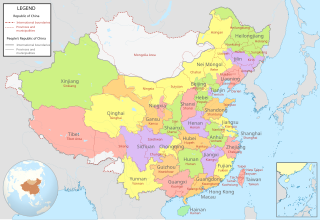
The history of the administrative divisions of China after 1949 refers to the administrative divisions under the People's Republic of China. In 1949, the communist forces initially held scattered fragments of China at the start of the Chinese Civil War. By late 1949, they controlled the majority of mainland China, forcing the Republic of China government to relocate to Taiwan.

Ismail Amat was a Chinese politician of Uyghur ethnicity who served as Chairman (Governor) of Xinjiang Uyghur Autonomous Region, State Councillor, Vice Chairman of the Standing Committee of the National People's Congress and Vice Chairman of the Chinese People's Political Consultative Conference (CPPCC).
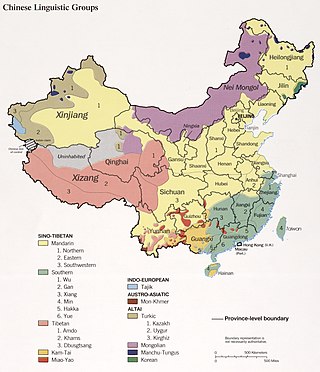
Ethnic broadcasting in China comprises both radio and TV broadcasting for some of the numerous ethnic groups within the country. Stations are found on the administrative levels of the nation as a whole, provinces, prefectures, and counties. They form a part of the ethnic media of China.

Secession in China refers to several secessionist movements in the People's Republic of China. Many current separatist movements in China arise from the country's ethnic issues. Some of the factors that have created these ethnic issues include history, nationalism, economic and political disparity, religion, and other factors. China has historically had tensions between the majority Han and other minority ethnic groups, particularly in rural and border regions. Historically, other ruling ethnicities, such as the Manchu of the early-Qing dynasty, experienced ethnic issues as well.
Uyghur nationalism is a nationalist movement which asserts that the Uyghur people, an ethnic minority in China, are a distinct nation. Uyghur nationalism promotes the cultural unity of the Uyghur people, either as an independent group or as a regional group within a larger Chinese nation.

The People's Republic of China (PRC) is divided into 2,854 county-level divisions which rank below prefectures/provinces and above townships as the third-level administrative division in the country. Of these, 2,842 are located in territory controlled by the PRC, while 172 are located in land controlled by the Republic of China (ROC).















